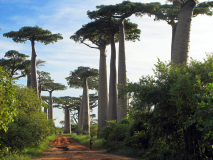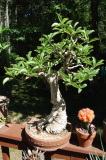- Store Shop
- >
- Medicinal-Edible Plants
- >
- Rare Baobab Tree
Rare Baobab Tree
SKU:
0
75
$0.00 - $75.00
Unavailable
per item
Buy The Baobab (Adansonia) Trees: Our Trees are Organically Grown 1 to 2 feet tall, 5+months old.
A Majestic magnificent Superfood also called the Tree of Life for it's high amounts of nutrition. Known to live up to 5000 years. Baobab is a drought-tolerant endangered species native to Madagascar Africa and Australia. 5+months old.
Don't be stocked by the size of the trees in the photo, they actually are hundreds + years to get to that size. These also make great Bonsai Trees.
About Baobab Spices:
Grandidieri: is the biggest and most famous of Madagascar's six species of baobabs. This imposing and unusual tree is endemic to the island of Madagascar, where it is an endangered species threatened by the encroachment of agricultural land.
Adansonia Digitata: is the most widespread of the Adansonia species, and is native to the African continent. The long-lived pachycauls are typically found in dry, hot savannahs of sub-Saharan Africa.
Suarezensis: is an endangered species of Adansonia endemic to Madagascar.
Samibarensis:is from Madagascar, It's leaves are quite different from Adansonia digitata, and it appears to be different from most of the other Madagascaran species.
Madagascariensis:Adansonia madagascariensis is one of six species of baobab endemic to Madagascar.
ZA:is endemic to Southern and North-Western Madagascar, where it is threatened by habitat loss.
Gregorii:Endemic to Australia, boabob occurs in the Kimberley region of Western Australia, and east into the Northern Territory. It is the only baobab to occur in Australia.
Perrieri: is an endangered species (northern Madagascar)
kilima: origin numbia This species has been confused with Adansonia digitata, It looks morphologically similar to Adansonia digitata, but differs from the latter about floral morphology.
*Baobab Leaves: Can be made into fine powder also exotic African cuisine.
The fresh leaves used for medicinal benefits contain high amounts of Vitamin C as well as other nutritional elements such as high protein content contains all 8 essential amino acids, minerals such as calcium, magnesium, manganese, potassium, phosphorus, iron, sodium, and zinc. 100 g of baobab leaves provide about three times the daily calcium requirements, twice the daily magnesium and copper requirements, and four times the daily manganese requirement.
A Majestic magnificent Superfood also called the Tree of Life for it's high amounts of nutrition. Known to live up to 5000 years. Baobab is a drought-tolerant endangered species native to Madagascar Africa and Australia. 5+months old.
Don't be stocked by the size of the trees in the photo, they actually are hundreds + years to get to that size. These also make great Bonsai Trees.
About Baobab Spices:
Grandidieri: is the biggest and most famous of Madagascar's six species of baobabs. This imposing and unusual tree is endemic to the island of Madagascar, where it is an endangered species threatened by the encroachment of agricultural land.
Adansonia Digitata: is the most widespread of the Adansonia species, and is native to the African continent. The long-lived pachycauls are typically found in dry, hot savannahs of sub-Saharan Africa.
Suarezensis: is an endangered species of Adansonia endemic to Madagascar.
Samibarensis:is from Madagascar, It's leaves are quite different from Adansonia digitata, and it appears to be different from most of the other Madagascaran species.
Madagascariensis:Adansonia madagascariensis is one of six species of baobab endemic to Madagascar.
ZA:is endemic to Southern and North-Western Madagascar, where it is threatened by habitat loss.
Gregorii:Endemic to Australia, boabob occurs in the Kimberley region of Western Australia, and east into the Northern Territory. It is the only baobab to occur in Australia.
Perrieri: is an endangered species (northern Madagascar)
kilima: origin numbia This species has been confused with Adansonia digitata, It looks morphologically similar to Adansonia digitata, but differs from the latter about floral morphology.
*Baobab Leaves: Can be made into fine powder also exotic African cuisine.
The fresh leaves used for medicinal benefits contain high amounts of Vitamin C as well as other nutritional elements such as high protein content contains all 8 essential amino acids, minerals such as calcium, magnesium, manganese, potassium, phosphorus, iron, sodium, and zinc. 100 g of baobab leaves provide about three times the daily calcium requirements, twice the daily magnesium and copper requirements, and four times the daily manganese requirement.
Sold out
















